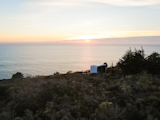150,000 Plastic Bottles Were Used to Create This 3D-Printed Tiny Home
Welcome to Prefab Profiles, an ongoing series of interviews with people transforming how we build houses. From prefab tiny houses and modular cabin kits to entire homes ready to ship, their projects represent some of the best ideas in the industry. Do you know a prefab brand that should be on our radar? Get in touch!
Ross Maguire has been a laborer on construction sites, holds a master’s in engineering, and started a few construction companies before moving from the U.K. to California in 2019. Soon after, he partnered with Gene Eidelman, a real-estate developer with a background as a construction executive, and the pair set out to find a better way to build residences. They founded Azure Printed Homes, which makes modular prefabs out of materials often treated as waste. "Each of our 3D-printed modules repurposes around 150,000 plastic bottles," Ross tells us. "These modules are approximately 200 square feet in size and can be printed in just 24 hours." Here, we ask the cofounder about the different models that Azure makes, how long it takes to fabricate them, and what's included with the purchase.
What’s the most exciting project you’ve realized to date?
We recently delivered one of our units to a remote site in Big Sur. The location offers awe-inspiring views of the rugged coastline. While we anticipated some challenges during the delivery and installation process, we were pleased to complete it within just 48 hours. This achievement is especially remarkable given the site’s isolation. Our customer is the owner of a wonderfully tranquil glamping vacation resort and shares our commitment to adopting a circular approach to creating living spaces. The sustainability aspect was a significant and appealing factor for the customer when choosing an Azure home.
What does your base model cost and what does that pricing include?
Our smallest model, the N-100, is 100 square feet and begins at $19,900. That includes all interior and exterior finishes, lighting, and power, making it ready for our customers to furnish. Each unit is prepped for a power connection, or alternatively, customers can opt to include a solar panel and battery, enabling the unit to operate independently of the electric grid. The entire manufacturing process for one unit takes only one week, and installation can be accomplished in just one day.
What qualities make your prefab stand apart from the rest?
Since our inception, we’ve observed a wide range of reasons why people are drawn to our units. Some are captivated by the unique designs and aesthetic appeal. Others are enticed by the remarkable speed and efficiency of our production process. Then there are those who simply look at the price tag and base their decision on cost alone. However, the overwhelming majority of our customers are deeply passionate about sustainability and the circular nature of our approach.
Our innovative process revolves around utilizing waste materials as a primary supply source, resulting in a system that generates no waste. Being able to create something beautiful and unique from a waste supply line is something that we are hugely proud of, especially given that our end product aims to address the housing crisis. It’s a true testament to the saying "one person’s trash is another’s treasure."
Where is the prefab currently available?
We currently manufacture our units in Southern California and we can load four of our smallest units onto one flatbed truck. We have already transported our units to the East Coast. Our growth plan is to set up multiple factories across the U.S. to serve neighboring states and reduce the delivery distances.
Is your design currently pre-permitted in any U.S. municipalities?
We work with third-party approval agencies across the country, enabling us to take care of all the building and safety requirements for the prefab module itself. The planning and utility approvals still need to be generated locally through the local municipality, but there is no need for approval of the design or fabrication itself.
Are there plans to expand to different parts of the world?
We do plan to branch out across the country in the near future and aspire to serve countries and communities across the world that are underserved with housing options. We’ve already seen great interest from Europe, Australia, and East Asia, where housing demands are high and the supply is short, inefficient, and expensive.
What aspects of an install do you manage?
We advise customers through all stages from planning to moving in. We can also make introductions and connections through the journey when local knowledge and expertise are necessary. Although the methodology of producing our units is technologically advanced, we have insisted on making the design and installation as simple as possible for our customers and partners.
How long can a client expect the process to take after they put down a deposit?
The lead time is different for each of our different prefabs types. As a guide:
- Studios: 2-4 weeks
- Wheel based units: 4-6 weeks
- ADUs & Homes: 4-8 weeks
What aspects of the design can a client customize?
We currently have three different model designs that are available across a number of different sizes and layouts. For each option, we have "families" of finishes that our in-house design team have chosen to serve the different tastes and styles of our customers.
More Prefab Profiles:
Tini Living Makes Tweakable Steel-Framed ADUs That Start at $38K
This Space-Age Pod Wants to Be Your New ADU, Office, or Off-Grid Micro-Home
Published
Stay up to Date on the Latest in Prefab Homes
From cozy cottages to large family houses, see how prefab continues to redefine the future of construction, building, and design.






